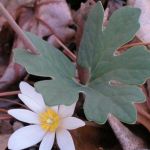| Common Name: |
Red Indian Paint |
| Other Names: |
Bloodroot, Red Puccoon |
| Botanical Name: |
Sanguinaria canadensis |
| Genus: |
Sanguinaria |
| Family: |
Papaveraceae |
| Native Location: |
Eastern N America |
| Cultivation: |
Well-drained, rich soil in sun or partial shade. |
| Propagation: |
By seed sown in autumn (species only); by cuttings or division of rhizomes in the late summer or early autumn. Rhizomes are brittle and should be handled carefully. |
| Harvest: |
Rhizomes are lifted in autumn and dried for liquid extracts, ointments, and tinctures. |
| Warning: |
Excess depresses the central nervous system, causes nausea and vomiting, and may prove fatal. Contraindicated during pregnancy and lactation. For use by qualified practioners only. |
| Height: |
15-60cm (6-24in) |
| Width: |
30-45cm (12-18in) |
| Varieties: |
Plena
syn. Flore Pleno, Multiplex
Has longer-lasting, double, white flowers. |
|
| Hardiness: |
Z3-8 |
| Parts Used: |
Rhizomes |
| Properties: |
A bitter, acrid, warming herb that has expectorant and diuretic effects, lowers fever, relaxes spasms, and slows heart rate. It is locally anesthetic and effective against many pathogenic organisms. |
| Medicinal Uses: |
Internally for bronchial, respiratory tract, and throat infections, and poor peripheral circulation. Externally for skin diseases, warts, nasal polyps, benign skin tumors, sore throat, and chilblains. Combined with Lobelia inflata (See, Indian Tobacco) for bronchial asthma; with Capsicum annuum (See, Sweet Pepper) and Salvia officinalis (See, Common Sage) as a gargle for pharyngitis; with Myrica cerifera (See, Bayberry) in snuff for nasal polyps, and with Chelidonium majus (See, Greater Celandine) to remove warts. Used in homeopathy for migraine. |
| Economic Uses: |
Extracts are added to toothpaste and mouthwash as an anti-plaque agent. |
| Bibliography: |
Encyclopedia of Herbs by Deni Brown Copyright © 1995, 2001 Dorling Kindersley Limited. Pp 357-358 |
